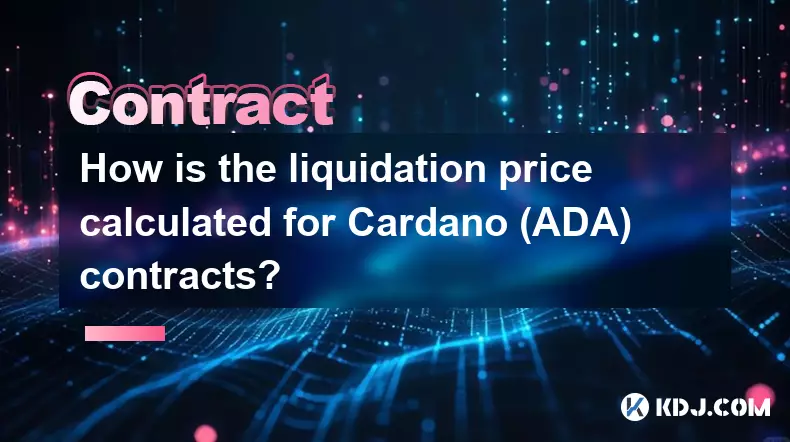-
 bitcoin
bitcoin $122090.672462 USD
1.59% -
 ethereum
ethereum $4493.758974 USD
0.56% -
 xrp
xrp $3.033145 USD
0.65% -
 tether
tether $1.000629 USD
0.00% -
 bnb
bnb $1169.854250 USD
7.07% -
 solana
solana $230.954786 USD
-0.19% -
 usd-coin
usd-coin $0.999785 USD
0.00% -
 dogecoin
dogecoin $0.256108 USD
-1.12% -
 tron
tron $0.342333 USD
-0.12% -
 cardano
cardano $0.859632 USD
-0.10% -
 hyperliquid
hyperliquid $48.932146 USD
-2.25% -
 chainlink
chainlink $22.345466 USD
-1.29% -
 ethena-usde
ethena-usde $1.000217 USD
-0.03% -
 avalanche
avalanche $31.203456 USD
1.93% -
 sui
sui $3.579145 USD
1.05%
How is the liquidation price calculated for Cardano (ADA) contracts?
The liquidation price in ADA derivatives depends on entry price, leverage, position size, and mark price, with higher leverage narrowing the buffer and increasing closure risk.
Sep 29, 2025 at 04:00 am

Understanding Liquidation Price in ADA Derivatives
1. The liquidation price for Cardano (ADA) futures or perpetual contracts is determined by the point at which a trader’s margin balance falls below the required maintenance margin. This occurs when losses on a leveraged position deplete the collateral supporting the trade. Exchanges use specific formulas based on entry price, leverage, position size, and fees to calculate this critical threshold.
2. For long positions, the liquidation price is generally lower than the entry price, while for short positions, it is higher. This reflects the directionality of risk—longs lose value as price drops, shorts as price rises. The formula adjusts dynamically with funding rates, accrued fees, and changes in mark price versus index price.
3. Most derivatives platforms rely on the mark price, not the last traded price, to determine liquidation. The mark price incorporates external price feeds and fair market value mechanisms to prevent manipulation and ensure stability during volatility. If the mark price hits the liquidation threshold, the position is closed automatically.
4. Fees and funding payments are factored into the calculation. Each funding interval, traders either pay or receive funds based on the rate differential between spot and perpetual markets. These periodic transfers affect the available margin and thus influence how close a position is to liquidation.
5. Higher leverage directly lowers the liquidation price buffer for longs and raises it for shorts, increasing the likelihood of forced closure during market swings. A 10x leveraged ADA long has a much narrower safe zone than a 2x position under identical conditions.
Key Variables Impacting ADA Contract Liquidation
1. Entry price is the starting reference point. All profit and loss calculations derive from this value. A position opened at $0.50 will have its liquidation level computed relative to that baseline, adjusted for leverage and fees.
2. Leverage multiplier plays a central role. If a trader opens a $1,000 position with 20x leverage, they only post $50 as initial margin. Smaller price movements can erase that margin, triggering liquidation faster than with lower leverage.
3. Maintenance margin requirements vary by exchange and contract type. Typically ranging from 0.5% to 1% of notional value, this minimum equity level must be sustained. Falling below it initiates liquidation regardless of further price movement potential.
4. Position size influences the total risk exposure. Larger positions require more margin and react more dramatically to price shifts. A 100,000 ADA short will face tighter liquidation constraints than a 10,000 ADA short at the same leverage.
5. Funding rate accruals impact account balance over time. In a high-funding environment, short positions may bleed margin continuously, accelerating their path to liquidation even without adverse price moves.
Role of Mark Price in Preventing Premature Liquidations
1. Exchanges use the mark price to reflect fair value rather than volatile spot trades. It is often derived from ADA’s spot price across major exchanges, smoothed using time-weighted averages or oracle systems.
2. By anchoring liquidation triggers to the mark price, platforms reduce the risk of flash crashes or pump-and-dump schemes forcing unwanted closures. A sudden dip to $0.30 on a thin exchange won’t liquidate all longs if the true market value remains near $0.48.
3. The difference between mark price and last traded price creates a buffer zone. Positions may appear underwater based on trade data but remain safe if the mark price hasn't breached the threshold.
4. This mechanism protects traders from artificial liquidations during low-liquidity events and ensures that closures occur only when genuine market equilibrium supports them.
5. Some platforms implement a tiered liquidation system where partial closures occur before full wipeout, preserving residual value when possible. These tiers also depend on accurate mark pricing to function correctly.
Frequently Asked Questions
What happens when an ADA contract gets liquidated?The exchange closes the position automatically, usually through a decentralized liquidator system or internal matching engine. Any remaining margin after covering losses may be returned, though some platforms charge a liquidation fee.
Can I avoid liquidation by adding more margin?Yes, most platforms allow margin top-ups before liquidation occurs. Increasing collateral raises the maintenance buffer and pushes the liquidation price further from the current mark price, giving the position more breathing room.
Does the ADA network status affect contract liquidation?No, liquidations occur entirely within the exchange’s derivatives engine and are independent of blockchain confirmations or network congestion. They are based solely on price data and account balances.
Are isolated and cross-margin modes calculated differently?Yes. In isolated margin, only the allocated funds are at risk, and liquidation depends solely on that position’s performance. Cross-margin uses the entire account balance, delaying liquidation until total equity falls below maintenance levels.
Disclaimer:info@kdj.com
The information provided is not trading advice. kdj.com does not assume any responsibility for any investments made based on the information provided in this article. Cryptocurrencies are highly volatile and it is highly recommended that you invest with caution after thorough research!
If you believe that the content used on this website infringes your copyright, please contact us immediately (info@kdj.com) and we will delete it promptly.
- BlockDAG, DOGE, HYPE Sponsorship: Crypto Trends Shaping 2025
- 2025-10-01 00:25:13
- Deutsche Börse and Circle: A StableCoin Adoption Powerhouse in Europe
- 2025-10-01 00:25:13
- BlockDAG's Presale Buzz: Is It the Crypto to Watch in October 2025?
- 2025-10-01 00:30:13
- Bitcoin, Crypto, and IQ: When Genius Meets Digital Gold?
- 2025-10-01 00:30:13
- Stablecoins, American Innovation, and Wallet Tokens: The Next Frontier
- 2025-10-01 00:35:12
- NBU, Coins, and Crypto in Ukraine: A New Yorker's Take
- 2025-10-01 00:45:14
Related knowledge

What is the difference between futures and perpetual contracts for Bitcoin?
Oct 02,2025 at 11:54pm
Understanding Bitcoin Futures Contracts1. Bitcoin futures are derivative instruments that allow traders to speculate on the future price of Bitcoin at...

What is the best time to trade PEPE contracts?
Oct 03,2025 at 11:54am
Understanding PEPE Contract Volatility1. PEPE contracts exhibit extreme price fluctuations due to their meme-based nature and low market cap. Trading ...

What are the common mistakes to avoid with Bitcoincoin contracts?
Oct 03,2025 at 08:54am
Emerging Trends in the Cryptocurrency Market1. Decentralized finance (DeFi) platforms continue to expand their influence across the blockchain ecosyst...

What is the maintenance margin for Bitcoin contracts?
Oct 02,2025 at 01:36am
Decentralized Exchanges Gain Momentum in 20241. Decentralized exchanges (DEXs) have seen a significant rise in trading volume, surpassing centralized ...

How to use technical analysis for trading XRP contracts?
Oct 03,2025 at 01:18pm
Understanding Price Patterns in XRP Futures1. Identifying chart patterns such as triangles, head and shoulders, and double tops or bottoms can provide...

What does "longing" PEPE contracts mean?
Oct 03,2025 at 11:54pm
Understanding Decentralized Exchanges in the Crypto Ecosystem1. Decentralized exchanges (DEXs) operate without a central authority, allowing users to ...

What is the difference between futures and perpetual contracts for Bitcoin?
Oct 02,2025 at 11:54pm
Understanding Bitcoin Futures Contracts1. Bitcoin futures are derivative instruments that allow traders to speculate on the future price of Bitcoin at...

What is the best time to trade PEPE contracts?
Oct 03,2025 at 11:54am
Understanding PEPE Contract Volatility1. PEPE contracts exhibit extreme price fluctuations due to their meme-based nature and low market cap. Trading ...

What are the common mistakes to avoid with Bitcoincoin contracts?
Oct 03,2025 at 08:54am
Emerging Trends in the Cryptocurrency Market1. Decentralized finance (DeFi) platforms continue to expand their influence across the blockchain ecosyst...

What is the maintenance margin for Bitcoin contracts?
Oct 02,2025 at 01:36am
Decentralized Exchanges Gain Momentum in 20241. Decentralized exchanges (DEXs) have seen a significant rise in trading volume, surpassing centralized ...

How to use technical analysis for trading XRP contracts?
Oct 03,2025 at 01:18pm
Understanding Price Patterns in XRP Futures1. Identifying chart patterns such as triangles, head and shoulders, and double tops or bottoms can provide...

What does "longing" PEPE contracts mean?
Oct 03,2025 at 11:54pm
Understanding Decentralized Exchanges in the Crypto Ecosystem1. Decentralized exchanges (DEXs) operate without a central authority, allowing users to ...
See all articles










































































